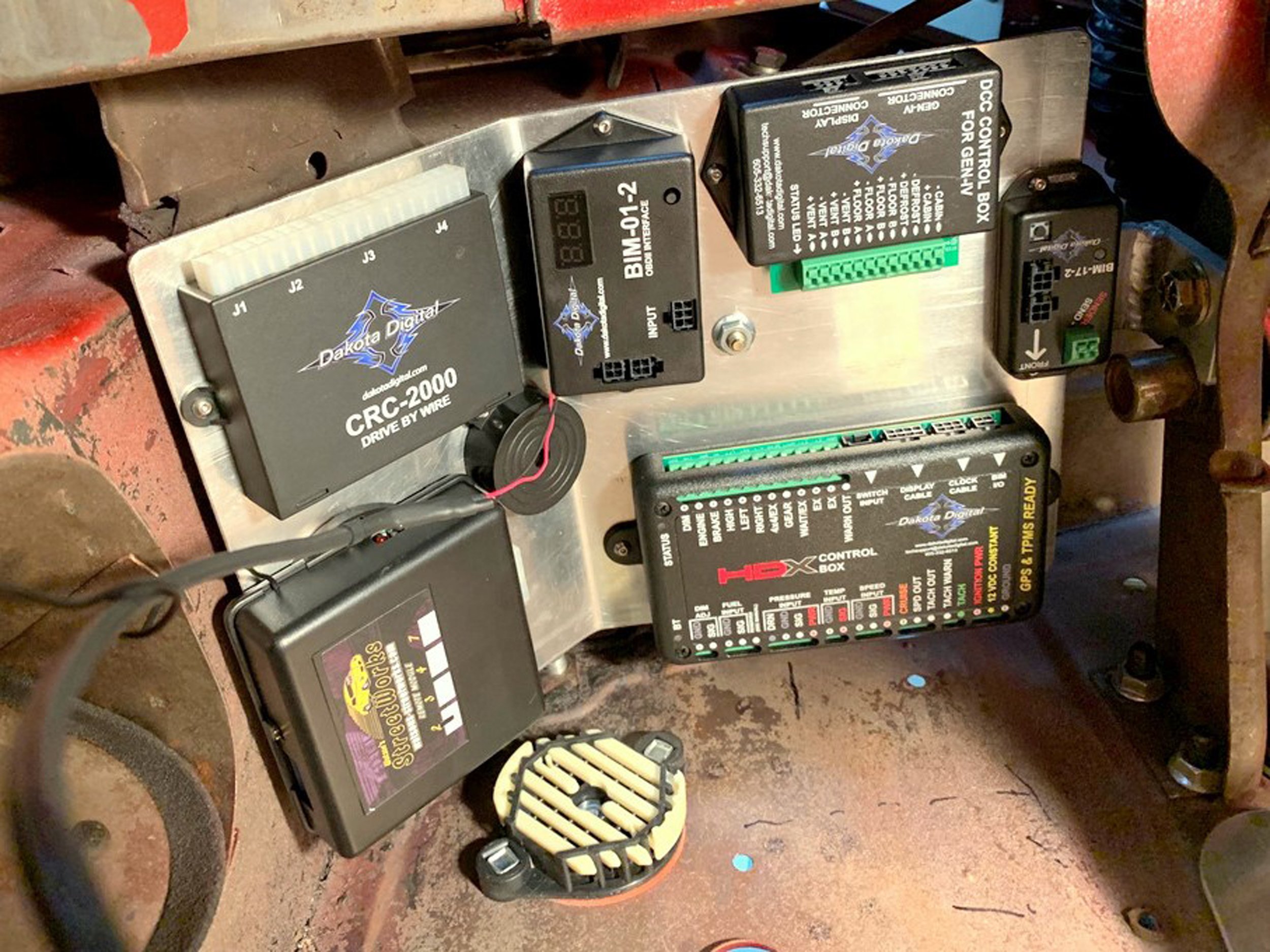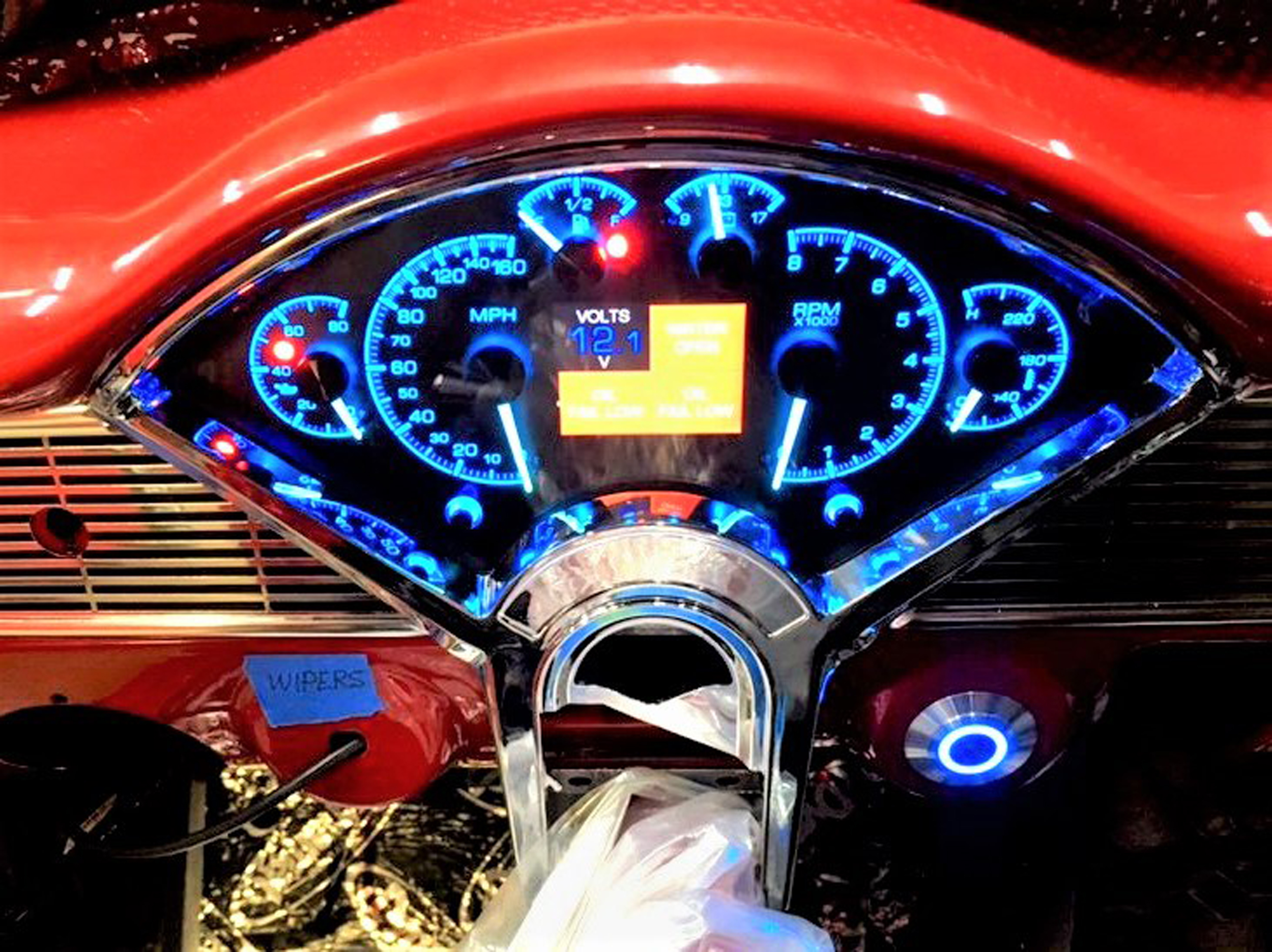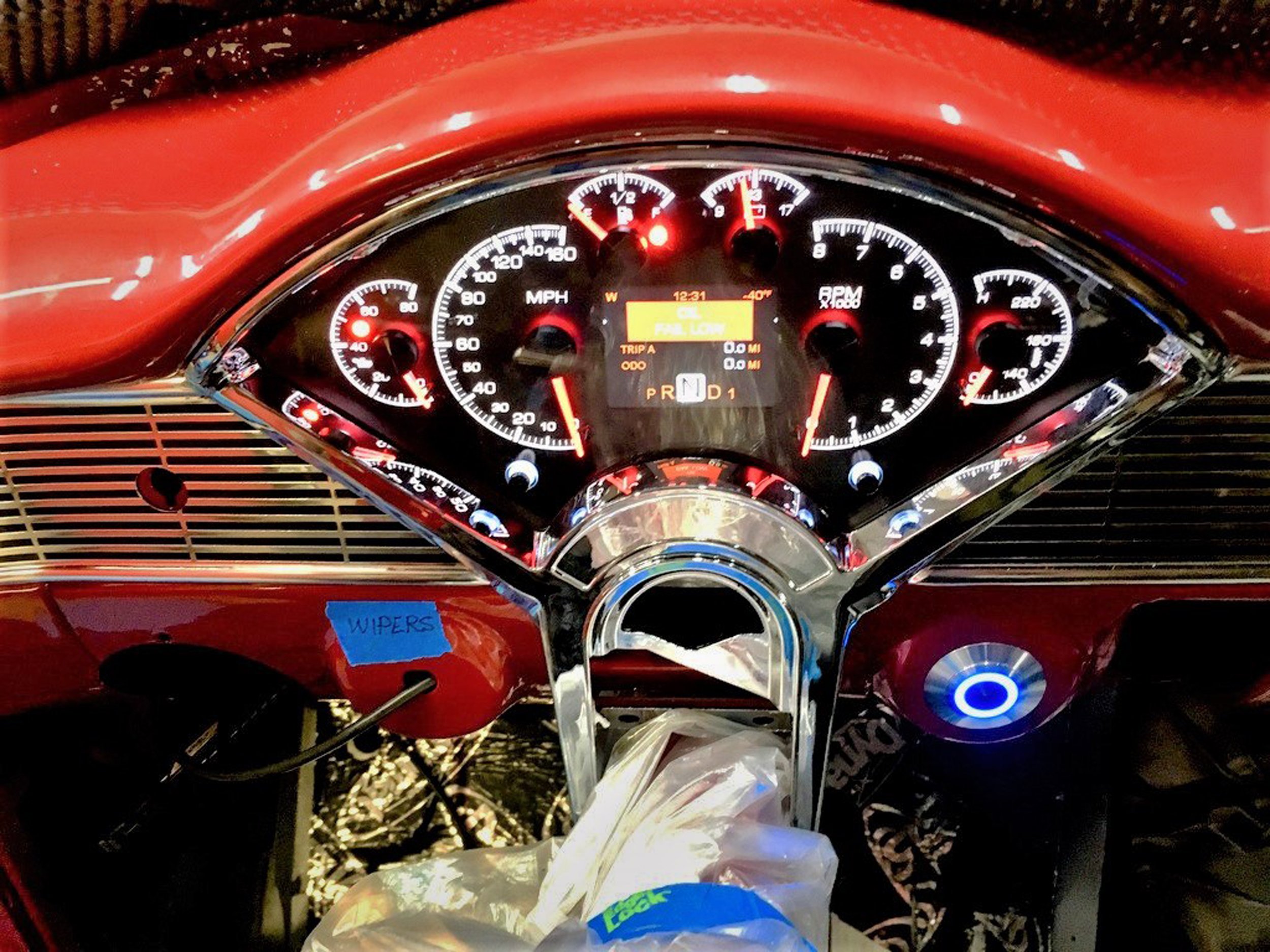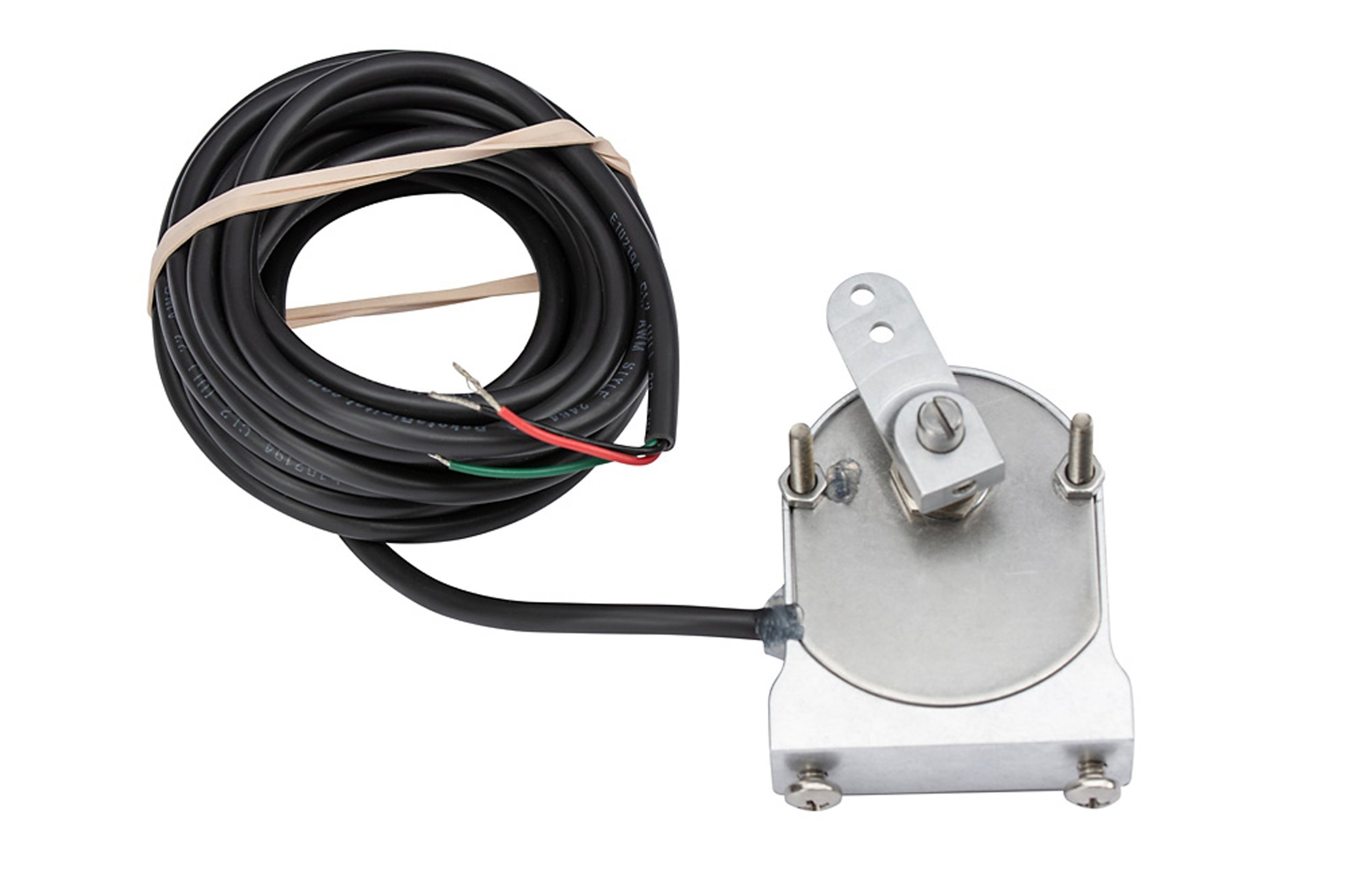One of the things that make driving our modern cars so enjoyable is the extent of information available to us while driving. Whereas previously, many autos were fitted with “idiot lights” that did little more than highlight the impending mushroom cloud, today’s autos use today’s serial data technology to encompass an incredibly broad scope of the car’s operating parameters.
One of the first digital gauge systems created by Dakota Digital was for the Tri-Five Chevys. Since then, it has continually evolved the system to include much of today’s technologies with an ever-expandable, daisy-chain-capable system of modules to include more options than you ever thought possible. Project Gift Horse has numerous modern touches throughout the build, and the car’s owner, Aubrey King wanted the dash and accompanying systems to be as modern as the rest of the build.

The Dakota Digital HDX features both analog and digital displays. It serves as the hub to which a truly capable information system can be created.
The Dakota Digital system allows for additional components much like a daisy-chain platform. Once you have the base componentry, Dakota Digital’s vast array of inputs is available through their BIM expansion modules for Dakota Digital RTX, HDX, VHX, and VFD3 instrument systems. With the requisite expansion modules, customers can add such inputs as a GPS speed and compass, OBD-II interface, a pressure module for boost, outside temperature, EGT/Head temperature, a wideband oxygen sensor, a clock module, and even tire pressure sensors. The Dakota Digital system is expandable with up to sixteen additional gauges to choose from.
Easy Expansion
Project Gift Horse received its Dakota Digital dash, and several expansion modules, including one for cruise control, HVAC controls, outside air temp, compass, and tire pressure monitoring system. All feedback is displayed within the dash assembly and any necessary calibrations can be done using the dash’s buttons. The Dakota Digital HDX digital dash is the foundation of the expandable system. Additional modules simply “daisy-chain” together to expand the scope of the vehicle’s capabilities. We asked Gift Horse’s builder, Mike Hoover about this add-on style of options for our ‘56’s dash. “It really is a plug and play system,” he said. “I’m not a programmer, and it really is quite simple! Even customizing the display is not difficult to do.”
Mike joined the HDX with several modules on a panel that he mounted up under the dash of Gift Horse.
That display refers to the Dakota Digital HDX unit designed to fit in the OEM dash opening. The six analog gauges include a speedometer, tachometer, oil pressure, water temperature, voltage, and fuel gauge. Each one of the analog gauges’ information can also be displayed on the large TFT display for digital accuracy. The HDX has either a black or silver gauge-face and each HDX system allows the user to select a broad range of independent illumination colors for the gauge readings needles, as well as the message centers. Calibration and personal settings are manipulated with the built-in, capacitive-touch buttons or the available Bluetooth app for Apple and Android devices.
Dakota Digital also offers a clock and A/C control that ties in with the rest of the dash for a color-coded, custom dash.
All HDX instrument systems feature indicators for turn signals, high beam, check engine, cruise control, parking brake, and two user-definable ones. There is also a red, settable warning light for each gauge. Installation is greatly simplified with vehicle-harness sourced signals and supplied solid state sending units connecting cleanly to their respective terminal. The HDX uses many sensors your car already has and updates its use in a more modern application.
The Benefits Don’t Stop There
While the HDX’s analog display system is impressive in its own right, the addition of the digital display center only makes the system more appealing. As we mentioned, adding modules expands the dash’s capabilities, but there are several upgrades already available within the base dash system. There are standard digital displays for items such as an odometer, trip meter, 12-hour clock, and estimated range. Included in the HDX are performance-minded readouts for items such as 0-60 mph timer, ¼- and 1/8-mile timer, ¼- and 1/8-mile trap speed, high-speed recall, and high-rpm recall. In the past, performance enthusiasts would pay a premium for components that could gather this performance information.
Besides the typical analog gauges, Dakota Digital has also given several digital readouts within the digital display area.
Mike informed us that installing the Dakota Digital system really isn’t complicated, but you’ll need a little bit of ingenuity to mount all the necessary modules for your application. Mike simplified the installation and wiring of the various modules by mounting them all on a panel that he then installed under the dash of Gift Horse. This allows for the removal of the panel for servicing, should the need ever arise. As it stands, Mike has added various capabilities and has around 10 modules on the panel currently. Additional mounting options may be necessary, depending on how much room your vehicle has under the dash.
Additional modules allow for niceties such as OBD-II integration, gear selector indicator sensor, and a GPS speed sensor. The GSS-3000 gear indicator also has provision for reverse lights and park/neutral safety.
Ala Carte, But All As One
Mike offered this one suggestion when looking to purchase a Dakota Digital dash for your ride, “Make sure you purchase the most recent version, as Dakota Digital seems to add capabilities to their systems regularly.” Since we ordered the Dakota Digital HVAC controls for Project Gift Horse, the company came out with a much more capable unit, so we upgraded as soon as the new unit was available. One of the major selling features of the new controller was that it could be color-coordinated with our dash unit, along with the optional dash clock, to make the entire dash look like a well-thought-out system instead of an assemblage of various components. This can go a long way in making your install look high-quality, instead of a hack-job.
The appearance of the digital dash is VERY customizable with different colors for both the pointers and the gauge faces.
One of the great things about hot rodding is the broad scope of expression possible when designing your particular hot rod. The beautiful thing about Dakota Digital’s dash system is that it provides a broad scope of personalization, tailor-fitting the install to your exact need. The fact that all those options begin with a single unit only increases the value of the upgrade. Dakota Digital offers many dash configurations that are direct-fit into street rods, hot rods, muscle cars, and even classics. Check out their website and see what the possibilities might be for YOUR favorite ride.































